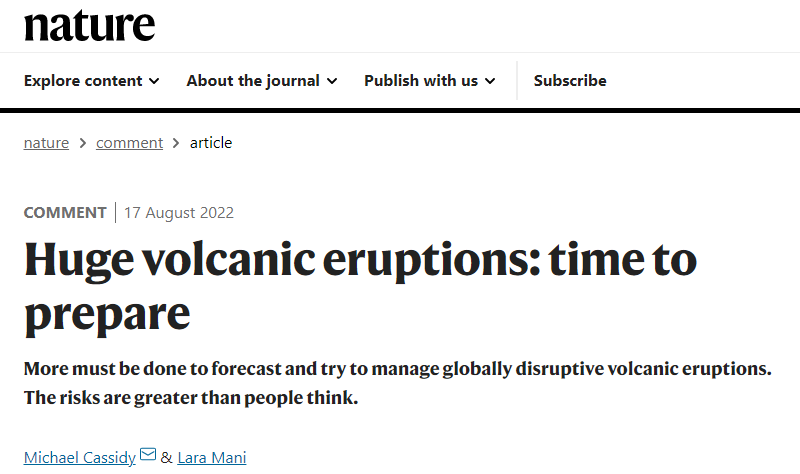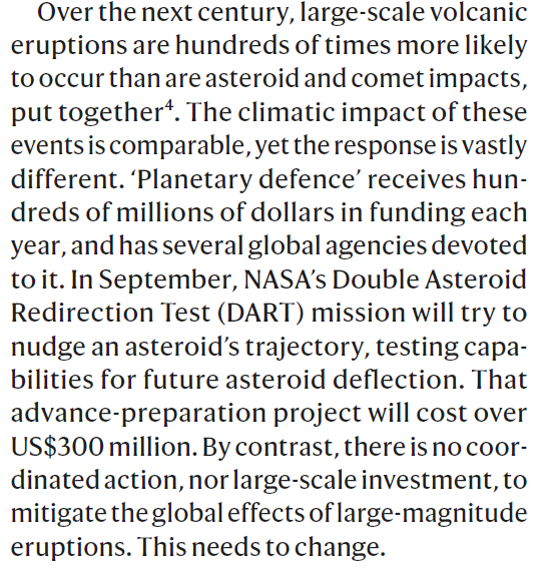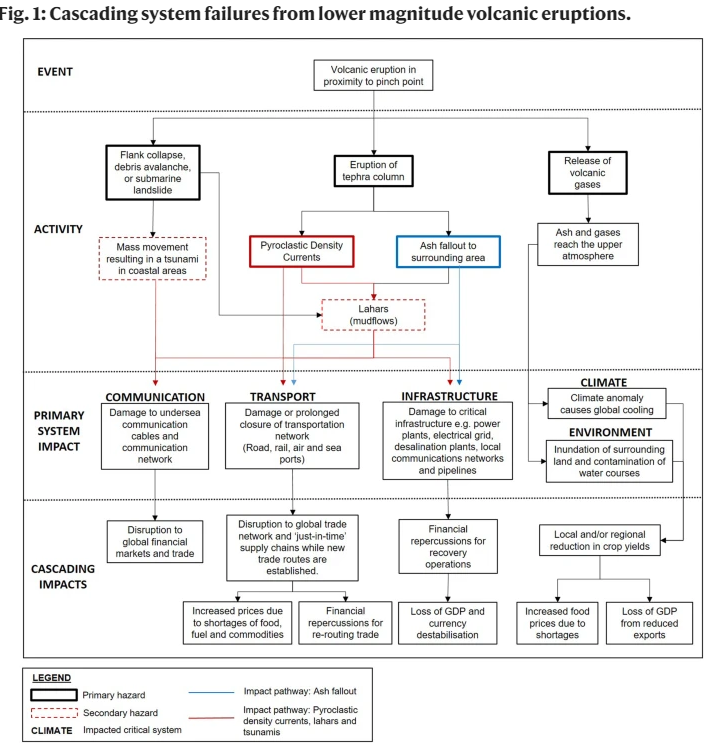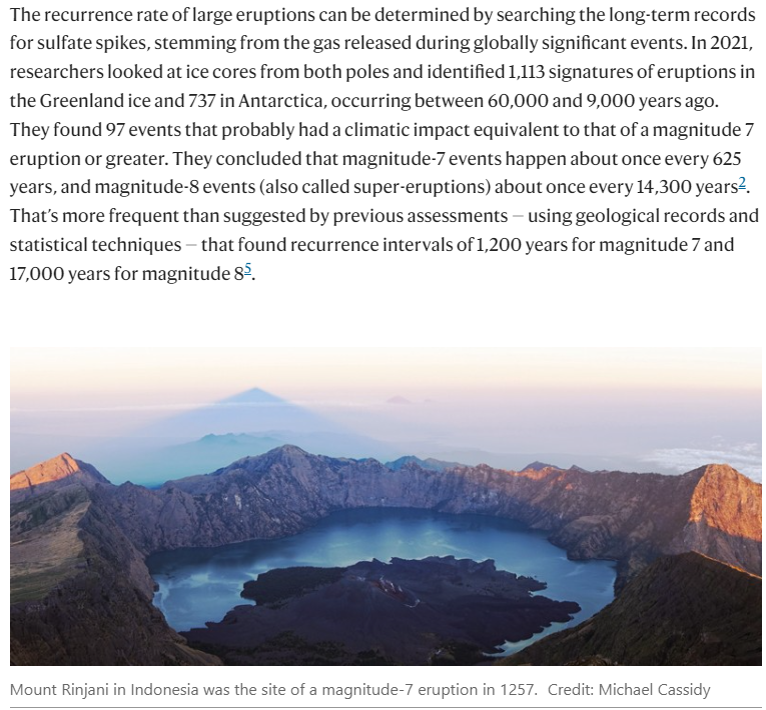Thread
@laramani14 & I have comment article in @Nature (www.nature.com/articles/d41586-022-02177-x), highlighting the risk from large eruptions & what we could do about them. I was a bit worried that some info might get misconstrued, so wanted to provide a bit of context🧵@new_ub @CSER @OxUniEarthSci 1/n
We want use this paper to call for more investment from funders (governments etc), to aid conversations we’re already having with policymakers, UN bodies, humariatarian orgs (e.g. @ifrc ) and researchers from other disciplines to take large volcanic risk more seriously
We also hope it will advance conversations to improve the global co-ordination of volcanic risk and response that are ongoing at @IAVCEI_official, see @andrewcraigtupp paper on this: link.springer.com/article/10.1007/s00445-022-01554-8
Volcanologists do amazing work throughout the world to reduce the volc risk from with limited resources and investment. But large eruptions cross borders and can cause large cascading impacts on the world. And we don’t have near enough resources for this currently!
This is stark contrast to asteroids and comets, where moderately sized impactor (up to a km) would have similar climatic consequences as a large eruption, yet a large volcanic eruptions are 100's times more likely to occur this century!
Planetary defense receives 100’s millions of investment each year & global coordinated agencies. And the new DART mission arriving next month will test our deflection (at a cost of >$300 million). Where is the investment and coordination to cover large volcanic events?
Currently we believe we’re unprepared for a large eruption (please tell us if you disagree) and we think that needs to change. Here’s some points from the comment article to highlight why:
While large eruptions will not lead to human extinction (by themselves). They do pose very large risks on modern society. Check out: pubs.geoscienceworld.org/gsa/geosphere/article/14/2/572/529016/Anticipating-future-Volcanic-Explosivi...
Impact on modern critical systems: www.nature.com/articles/s41467-021-25021-8 as well great books like: www.amazon.co.uk/Eruptions-Shook-World-Clive-Oppenheimer/dp/0521641128
Impact on modern critical systems: www.nature.com/articles/s41467-021-25021-8 as well great books like: www.amazon.co.uk/Eruptions-Shook-World-Clive-Oppenheimer/dp/0521641128
The last magnitude 7 eruption (Tambora 1815) which is 10 or even 100 times larger than the recent Tonga eruption, led to famine, disease outbreaks and volcanic winters, and Frankenstein @TimHarford Podcast: timharford.com/2022/06/cautionary-tales-frankenstein-versus-the-volcano/
But we’re more resilient to volcanic eruptions now right? Yes in many ways, but we have 8 times the population and 1000 times more global trade. Climate change compounds how we’d cope too and alters the risk. The interconnectedness of our world may cause cascading impacts.
Recent studies show this has a probability of an eruption equivalent to Tambora is 1 in 6 this century! And about ~ 1 in 170 for a super eruption. If there was a roll of a dice chance your house would fall down, I think you'd try to do something about it, right?
That’s all great n’all Mike, but shouldn’t we just focus on reducing the risk from smaller more frequent eruptions? Well, the steps were advocating for in this paper would also help reduce loss of life and other impacts from these more frequent eruptions.
The economic case for looking into extreme volcanic risk mitigation is solid.Using expected value theory, even though these events occur every ~630 yrs, estimated damages are >multi-trillions. So even investing 10% in volc risk reduction would constitute >100 mill per year!
But is there much we can do to actually reduce the risk from these large eruptions though? Yes and this is the point of the paper:
Firstly we don’t know where most of these large eruptions from ice records have come from. More geological record work (e.g. marine cores) would pinpoint this. We should also understand the most exposed & vulnerable regions to people, infrastructure, trade etc. figure:@PaulCole23
Better Monitoring would give us warning, both pre and during an eruption. Ground based - but also dedicated satellites (www.discovermagazine.com/planet-earth/lets-build-an-orbital-volcano-observatory) or pseudo satellites (HALE drones). Time gives us lots of options and allows for evacuations and prepreredness
Preparedness - things like now-casting - tailored geogrpahic info to people's phones- could save millions of lives (we’re having some conversations with @ifrc about this), but also community education like this success story: www.nature.com/articles/s41467-022-31901-4
We can start to think about research volcano geoengineering for the future: e.g. accelerating the removal of sulfur aerosols in the stratosphere to minimise volcanic winter or altering the magma or country rocks to alter the magmas potential explosivity.
Lots of obvious risks here, which requires debate and lots of sci research to remove uncertainty about safety and ensure efficacy. (Writing about this currently with ethicist @anderssandberg).
So hopefully we as a community can start to think bigger picture, like other scientific disciplines and make key gains on volcanic risk mitigation from small to large eruptions. We hope this triggers some debate discussion and interest in mitigating large eruptions!
Special thanks to @nicolakimjones @S_OhEigeartaigh, @CSER, Jake Lowenstern and other reviewers to make this better. Let us know if you want to chat and get involved in this work in the future!







